For Quan-text
You don't have to turn the clock back too far and quantum computing was more of an outlandish idea than a reality. Its growth however now appears to be accelerating – the patent system (as it has done for other emerging technologies) stands as a record of the huge progress made and those who now strive forwards at its forefront.
Just last week, the EPO published the second in a series of insight reports related to quantum technologies, in which it presented its findings as to the increase in new filings and number of patent families over the last 30 years, and provided analysis on how roughly 10% of recent European patent applications in the field have several applicants, indicating cooperative research around the world.
In this article, we discuss the origins of quantum computing and its recent emergence as a distinct category in the patent classification space, and statistics over a more recent timeframe, indicating who is currently, and who may soon be, spearheading quantum computing developments.
Prime Time
The theoretical possibility of quantum computing was first posited around 19801. In 1994 what is known as Shor's Algorithm2 appeared. This was an algorithm which if run on a supposed quantum computer would offer a means of finding the prime factors of very large numbers within a reasonable length of time, something not possible with conventional computers but which would be of considerable significance in the real world. At that time no actual quantum computer existed, but the prospect of implementing the algorithm in practice seems to have provoked a surge of interest.
The first demonstrations3 of actual quantum computing were reported a few years later, in 1998. Now, another 25 or so years later, a variety of quantum computers do exist4. Quantum computing might be considered to have transitioned from a subject of obscure academic research to a nascent technology which is receiving considerable investment. Patent applications with quantum computing as their subject-matter are now appearing in growing numbers.
In 2019 this was reflected in the addition to the International Patent Classification (IPC)5 of a distinct category related to quantum computing6:–
"G06N 10/00 Quantum computers, i.e. computer systems based on quantum-mechanical phenomena [2019.01]"
In 2022 this was refined to:-
"G06N 10/00 Quantum computing, i.e. information processing based on quantum-mechanical phenomena [2022.01]
- G06N 10/20 Models of quantum computing, e.g. quantum circuits or universal quantum computers [2022.01]
- G06N 10/40 Physical realisations or architectures of quantum processors or components for manipulating qubits, e.g. qubit coupling or qubit control [2022.01]
- G06N 10/60 Quantum algorithms, e.g. based on quantum optimisation, or quantum Fourier or Hadamard transforms [2022.01]
- G06N 10/70 Quantum error correction, detection or prevention, e.g. surface codes or magic state distillation [2022.01]
- G06N 10/80 Quantum programming, e.g. interfaces, languages or software-development kits for creating or handling programs capable of running on quantum computers; Platforms for simulating or accessing quantum computers, e.g. cloud-based quantum computing"
New patent applications relating to quantum computing will now be classified, and past applications reclassified, to the new categories. This refinement of the IPC should help track developments in distinguished areas within the field of quantum computing.
Although not all past applications related to quantum computing will already have been reclassified into the new quantum computing categories [G06N 10/00, G06N 10/20, G06N 10/40, G06N 10/60, G06N 10/70 or G06N 10/80] it seems most likely that relevant applications would at the time have been classified into a more general group "G06N 99/00"7. Taking this into account, patenting activity in recent years related to quantum computing can be estimated using the EPO's Espacenet database8.
Power Surge
One measure of patenting activity is the number of new families of quantum computing patent applications appearing each year across all the countries covered by the EPO's Espacenet database9. A family of patent applications (which may include granted patents) is made up of one or more patent publications that relate to the same invention/technical development. It may include publications in different countries and/or different publications in the same country (e.g. publications of the application and then of the granted patent). Generally, all members of the family claim the same priority. A new family appears with the earliest publication of any member of the family by any patent office.
From 2016 to 2021 the numbers of quantum computing families according to the Espacenet database have grown significantly, albeit from a very low level. From the information available up to the end of last year the trend of growth has continued in 2022.
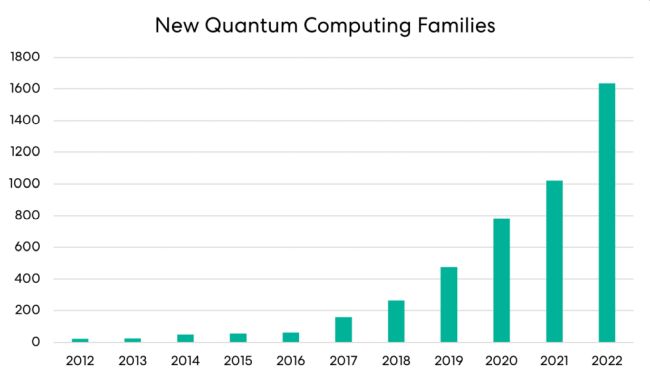
Source: EPO's Espacenet, Jan 2023
The companies recently active in the field of quantum computing may be of particular interest. One indicator is the numbers of patent application families associated with particular applicants. This can be estimated, but counting families depends e.g., on how families belonging to related but legally distinct companies are handled, how families belonging to joint applicants are counted and particularly how translations of names and variations in naming of applicants are handled. That said, the table indicates the estimated top fifty applicants in terms of their numbers of new quantum computing families since 2019. These top fifty applicants accounted for around 50% of all new quantum computing families since 2019.
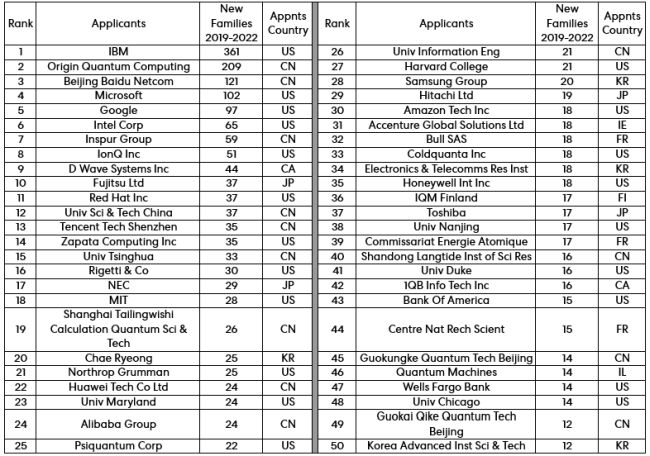
Source: EPO's Espacenet, Nov 2022
By far the majority of the top applicants in the table above are American or Chinese. Using the priority countries of patent application families as a guide to the geographical origin of the technical developments/inventions with which the families are concerned, it appears the US has by far most often been the country of origin of technical developments/inventions in the field of quantum computing, seen below from 2012 to 2021. However, based on a dataset up to the beginning of November 2022, it appears that China will have overtaken the US in terms of new patent application families appearing in 2022.
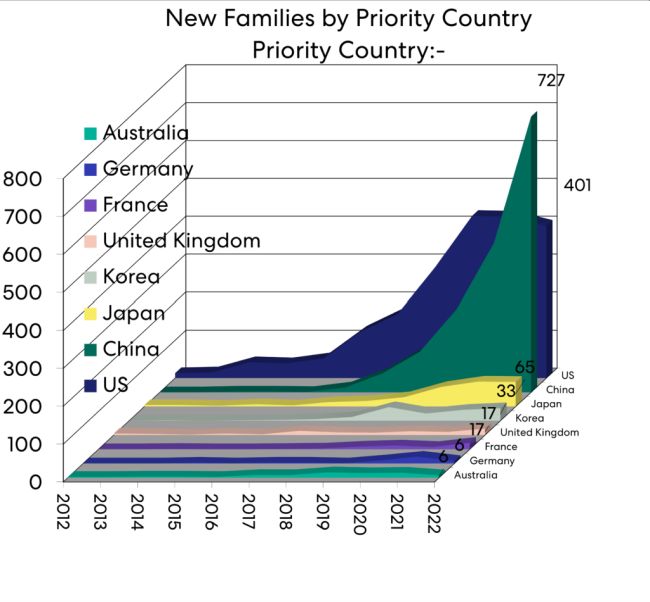
Source: EPO's Espacenet, Nov 2022
The IPC main group and subgroups (e.g. G06N 10/20) allotted to patent application families might be used to estimate the main technical aspects of quantum computing which are the concern of the patent families.
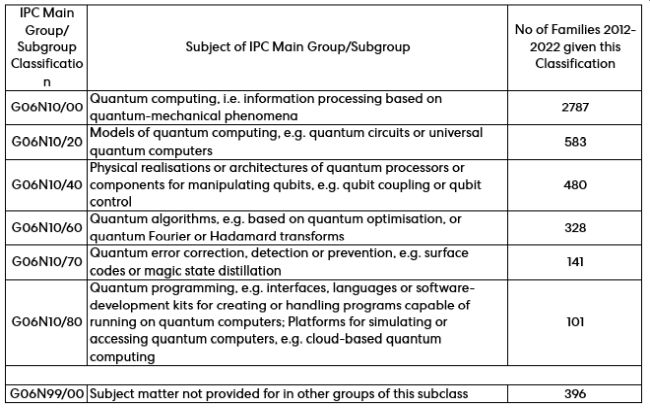
Source: EPO's Espacenet, Nov 2022
Families may, of course, be given more than one IPC classification, i.e. may be classified as relating to more than one IPC main group or subgroup and therefore to more than one aspect of quantum computing technology.
Focusing now on European patent applications, information in the EPO's "Bulletin Search" database10 indicates that the numbers of published European patent applications related to quantum computing have also increased significantly since 2016 (and particularly in recent years), as illustrated in the chart below for the period from 2012 to 2022.
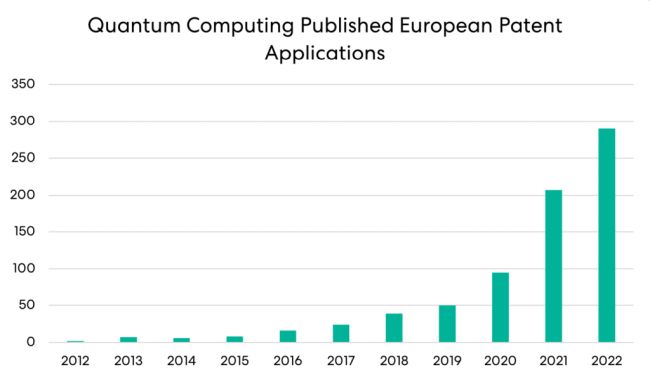
Source: EP Bulletin Search, Jan 2023
The table below indicates the top forty or so applicants in terms of their numbers of published European patent applications in the quantum computing field since 2019. These top applicants account for over 80% of all published European patent applications in the field since 2019.
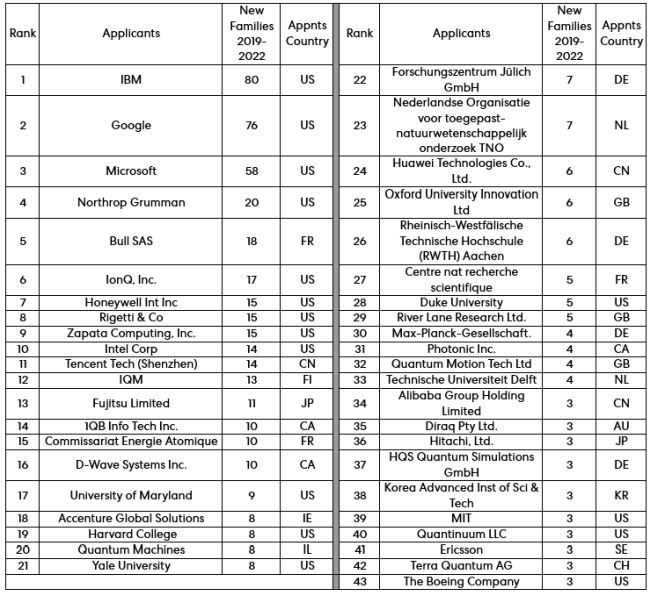
Source: EP Bulletin Search, Jan 2023
It may be worth noting that in 2019 only around twenty different applicants were responsible for published quantum computing European patent applications; in 2022 around ninety different applicants have been involved. It appears that as interest and research into the technology has surged in recent years, so has the range of applicants.
As for other technologies such as AI/machine learning, the surge in patent filings directed to quantum computing demonstrates the investment and effort that continue to be applied along the path to quantum advantage.
Footnotes
1 For example “Simulating Physics with Computers” Feynman,
https://doc.cat-v.org/feynman/simulating-physics/simulating-physics-with-computers.pdf; or
“The Computer as a Physical System: A Microscopic Quantum Mechanical Hamiltonian Model of Computers as Represented by Turing Machines”, Benioff https://sci-hub.se/10.1007/bf01011339
2 Polynomial-Time Algorithms for Prime Factorization and Discrete Logarithms on a Quantum Computer, Shor; https://arxiv.org/pdf/quant-ph/9508027.pdf
3 For example “Experimental Implementation of Fast Quantum Searching” Chuang, Gershenfeld & Kubinec, https://cba.mit.edu/docs/papers/98.03.grover.pdf; “Implementation of a Quantum Algorithm to Solve Deutsch's Problem on a Nuclear Magnetic Resonance Quantum Computer” Jones & Mosca, https://core.ac.uk/download/pdf/25229498.pdf
4 For example:-
https://newsroom.ibm.com/2021-11-16-IBM-Unveils-Breakthrough-127-Qubit-Quantum-Processor
https://quantumai.google/hardware
https://www.rigetti.com/what-we-build
https://www.dwavesys.com/solutions-and-products/product-overview/
5 The International Patent Classification (IPC) can be accessed at:- https://www.wipo.int/classifications/ipc/en/
6 The new quantum computing classification group was introduced under the general subclass heading “G06N Computing arrangements based on specific computational models”.
7 G06N 99/00 is the catch-all group under the G06N subclass (“G06N 99/00 Subject matter not provided for in other groups of this subclass”)
8 The new Espacenet database can be accessed at:- https://worldwide.espacenet.com/. The database query used was:- ((ipc = “G06N99/00/low” NOT ipc = “G06N10/00/low”) AND ti = “quantum”) OR ipc = “G06N10/00/low” with the filters: Earliest publication date (family): 2012-01-01 To 2022-12-31
9 The countries covered by the Espacenet database can be seen at:-
https://www.epo.org/searching-for-patents/technical/patent-additions.html
10 The EP Bulletin Search database can be accessed via:- https://data.epo.org/expert-services/index.html
The database query used was:- IPC=G06N0010* OR ((IPC=G06N0099* and (TTLE=quantum or TTLF=quantum or TTLG=quantum) andnot IPC=G06N0010* ))
https://newsroom.ibm.com/2021-11-16-IBM-Unveils-Breakthrough-127-Qubit-Quantum-Processor
https://quantumai.google/hardware
https://www.rigetti.com/what-we-build
https://www.dwavesys.com/solutions-and-products/product-overview/
The content of this article is intended to provide a general guide to the subject matter. Specialist advice should be sought about your specific circumstances.

